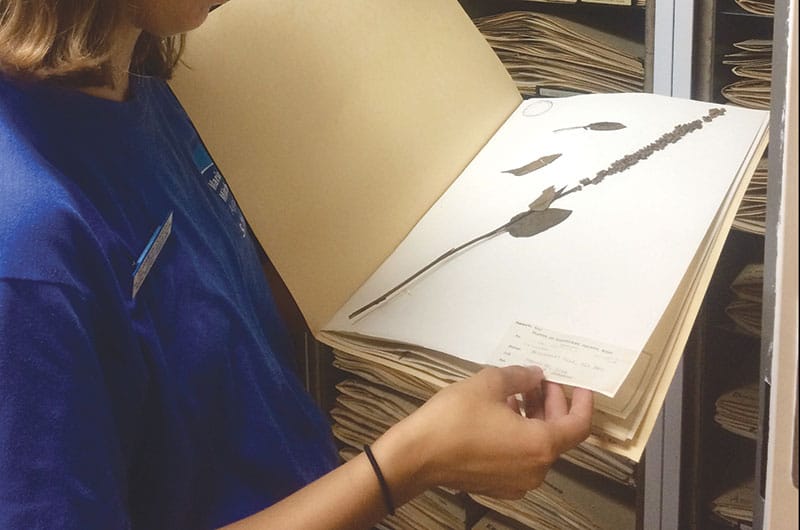
Maria Mitchell, the first woman astronomer in the U.S., was alive during this craze and may have had a few fern-inspired decorations of her own. The fern mania of the 1800s was popular across gender, age, and social class. Ferns started appearing in and on décor of many types including architectural design, papers, textiles, china and glassware, gravestones, greeting cards, and other decorative pieces. There are over twenty-five species of ferns in the MMA collection. When you open the doors of the cabinets to the historical collections themselves, you are immersed in a floral aroma. With fauna spanning over 137 years ( 1879-2016), there is a variety of colors, textures, and smells hidden within the manila folders.
The biological collections at the MMA include more than 4,000 plants representing 1,223 species. The MMA’s herbarium (the plant collection) is one of the most used collections in the Science Museum. Researchers add specimens each year, visit the collection to check identifications, and even take small samples for genetic studies. Recent work involves genetic analysis with Queen Anne’s Lace and Spotted Knapweed. The Nantucket Conservation Foundation and the Linda Loring Nature Foundation are working together to update the list of all plant species on the island and any collected specimens are donated to the MMA.
Next time you are out for a walk,take a scratch-and-sniff tour of Nantucket’s botany. The island is home to a variety of diverse plant species. Listed below are some that will excite your olfactory senses.
Bayberry (Morella pensylvanica) is an upright shrub that grows from five to eight feet in height. The flowers bloom in early spring, and the female plants produce small greyish-blue fruit in the fall. The bayberry is a strong scented fruit that was originally a source of pleasant smelling wax candles for early settlers; the scent of the bayberry is still used in candle making today.
Wintergreen (Gaultheria procumbens), like the gum flavor, has a sweet and spicy mint smell. The plant is a creeper (growing low along the ground) with oval leaves which are a dark green with a glossy sheen. In the autumn, the leaves turn to red or bronze.
The Slender fragrant Goldenrod, Euthamia caroliniana, is an herb that gives off a strong odor of paint thinner when the leaves are crushed. In the late summer and fall, yellow flowers cover the top of these plants. Other scents like Sassafras, which is spicy and fragrant, or Sweet fern are easy to find if your senses are turned on.
Nantucket is prodigious in its plant species – some invasive and others with healing properties. Transferred by bird excrement, or soil and human migration, many plants on Nantucket are non-native species. One of those is the Purple Loosestrife, or Lythrum salicaria, a purple perennial plant that grows in wetlands. One purple loosestrife plant can produce two million seeds annually, which are easily dispersed by water, livestock, people, and aquatic life. The invasion of the purple loosestrife in Nantucket wetlands often suppresses the plants native to the area and alters the wetland ecosystem; there is no effective method to control the spread of this invasive species.
Spotted jewelweed, Impatiens capensis, is a tall leafy plant with translucent stems and orange flowers with red splotches. The pods on the flowers explode and disperse seeds when touched – which explains their nickname: “touch-me-nots.” The spotted jewelweed grows in a variety of environments and contains properties that relieve the itchy symptoms of poison ivy. Between invasive species and nature’s healing properties, Nantucket’s fauna has a lot to offer (including inspiration for Victorian art crazes and a variety of smells). “Nantucket is a great place to explore botany both for beginners and experts,” says Andrew Mckenna-Foster, Director of Natural Sciences at the MMA. “There are lots of berry producing plants and aromatic plants for novices and some species that are hard to find regionally, but common here for the seasoned botanist.”
If you’d like to see some of the historic plant specimen collection at the Hinchman House Natural Science Museum, stop by 7 Milk Street. The MMA was founded in 1902 to preserve the legacy of Maria Mitchell and to promote her belief in learningby- doing. An astronomer and natural scientist, as well as an educator, Maria Mitchell shot to worldwide fame when she discovered a comet in 1847. For her discovery, she was awarded a gold medal from the King of Denmark – the first American and first woman to receive the honor. She served as the Professor of Astronomy and Mathematics at Vassar College from 1865 until 1888. Today, the MMA operates two observatories, a natural science museum, an aquarium, and the birthplace of Maria Mitchell. The MMA conducts scientific research, leads classes and workshops for people of all ages year-round, and welcomes thousands of visitors to its museums and observatories. For details, visit mariamitchell.org.


